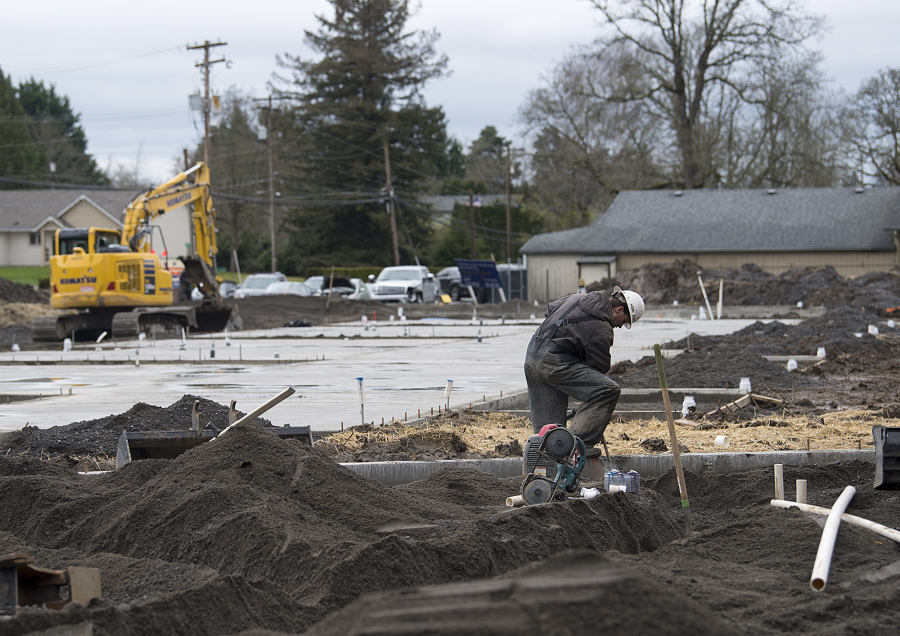Apartment construction in the suburbs of Portland is the most active it’s been since 1996. After an intense two years of low vacancies and high rents, the influx of new units may slowly provide some relief to renters.
That’s according to the spring Barry Apartment Report from Portland-based apartment appraisal specialists Barry & Associates.
There has been a rapid increase in urban land value, and available land is becoming scarcer.
“That pushes apartment developers out to the suburbs, where you can get more bang for your buck,” said Patrick Barry, a certified general appraiser.
Rents in Portland are driving increased demand for apartments in the suburbs of Portland, which includes Clark County, he said. Among four counties in the Portland metro area (Multnomah, Washington and Clackamas counties in Oregon, along with Clark County) building permits were issued for 7,650 new units in 2016. Fifteen percent, or 1,147 units, were in Clark County. Clark County has more proposed apartment projects than Clackamas County and suburban east Portland combined.
Barry & Associates expects developers will apply to build between 14,000 and 18,000 more apartment units in the Portland metro area through 2018.
Last year, apartment values increased, but the increases were driven largely by suburban properties and new construction, the report said.
“While values have risen across the entire metro area, not all increases have been equal,” the report said, adding that Clark County and areas east of Interstate 205 saw the biggest value increases.
For instance, in 2013 the median value of an apartment unit in Clark County built between 1960 and 2000 was $69,756, according to Barry’s analysis of data from CoStar Group Inc., a commercial real estate marketing company. Three years later that median value was $100,037 — an increase of 43 percent. The year-to-year increase from 2015 to 2016 was 30 percent.
The value of newly built apartments is much higher, Barry said. However, he added, older apartments that are renovated compete with average-quality new construction apartments in terms of value and potential tenants.
Although incoming supply is slowly chipping away at the shortage of units, it’ll still be a tight market in areas with limited apartment construction for the foreseeable future, the report said. Most projects in Vancouver are in the pre-application or review stage rather than under construction. Much construction activity is concentrated in the downtown, west Vancouver area.
“Due to questions surrounding inclusionary zoning and hesitation from developers, we expect a slowdown in the application for apartment permits,” the report said. “However, the projects in the pipeline will take a few years to materialize and the slowdown in permit applications may help the large backlog of units to be absorbed.”
As Oregon begins increasing regulations, such as requiring landlords to pay tenants’ relocation fees, the Vancouver market becomes more and more attractive to owners and investors, Barry said.
“There are a lot of people who’ve never invested in Clark County who are seeing it as an alternative to Portland,” he said.
The Oregon Legislature is considering lifting the ban on rent control, capping rent increases and prohibiting landlords from terminating a month-to-month tenancy without cause, according to The Oregonian. If any of those proposals move forward, it’ll impact Vancouver, Barry said.
Home ownership, interest rates and shifts in the political climate can all impact the local rental market as well. What if population or job growth slow down? What if there’s another recession? Those are unknown variables.
While the Barry Apartment Report predicts that rental vacancies in the metro area will increase to 4.5 percent by the end of 2017, vacancies will remain lower in the suburbs. Clark County may see a vacancy rate closer to 4 percent, while Portland’s may grow to 5 percent, Barry said.
For a long time, Clark County’s rental vacancy rate has hovered around 2 percent. People looking for rentals may notice that incentives are being offered again as the market becomes more competitive. Some listings on craigslist.org are advertising two weeks’ free rent, or $500 off first month’s rent, no move-in fees, and water/sewer/gas included along with free cable.
It may be strange to recall, but in 2006 Portland was among a list of 10 major cities considered the least expensive rental markets. Back then, average rent was $740 per month, according to Marcus and Millichap, a Portland-based real estate brokerage firm. Today, it’s more than twice as high and Portland appears on lists of the most expensive rental markets.




